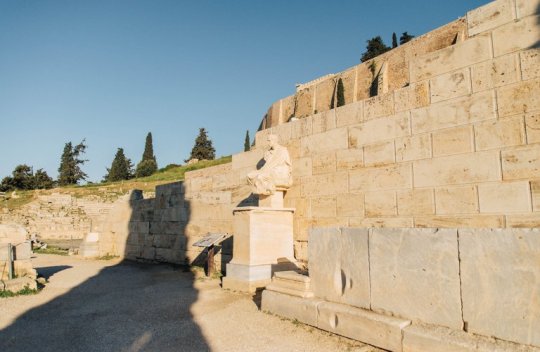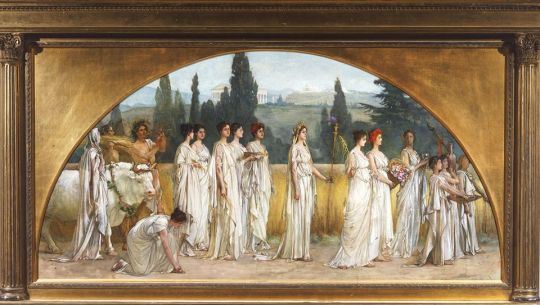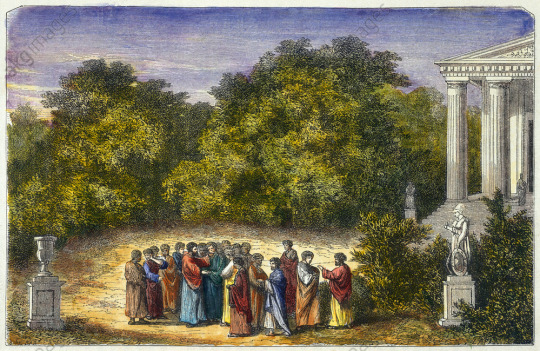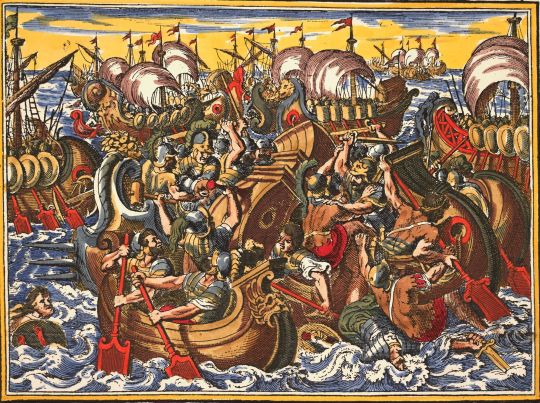Text
The Acropolis & Parthenon
First, let's take a look at one of the most famous sites in Ancient Greece. The Acropolis. The Acropolis is known as a sanctuary for the goddess Athena and was constructed in the 8th century B.C. Though this site was captured and destroyed by the Persians in 480 B.C, it was later rebuilt. Furthermore, the Acropolis “became a kind of museum or theater of memory, linking in the “glory days” of Athens”. This location is an important citadel and is used as a new gateway for water. Additionally, it includes some of the most famous buildings such as the Parthenon. The Parthenon was built under the artist Phidias in 432 B.C. It was the center of religious life in the city of Athens and represented the worship of the goddess Athena. There were two orders of classical architecture which included the Doric and Ionic. The Parthenon was made with two distinct Greek cultures. It is revealed that people of Dorian origin are considered more “manlier” since they were from Northern Greece. On the other hand, the Ionians are people of Eastern culture, have more wealth, and present a “feminine elegance”. People would come and pay respect to their goddess and seek divine repayment in kind. There is one specific structure that most Athenian people are drawn to which was the Frieze. People would speak of myths and theories as to how the Frieze was portrayed. This made some Athenians become skeptical of the gods and would feel as though they were filled with losses. However, these feelings were dismissed after as it remains a treasury to the city. The Frieze was made to establish a sense of divinity. Overall, these classical Greek foundations are important for archaeologists today for conservation and study of Ancient Greek Culture.
Glowacki, Kevin T. “The Acropolis.” The ancient city of Athens: Accessed November 8, 2021. https://www.stoa.org/athens/sites/acropolis.html.
Adair, Mark J. 1990. “A Dream in the Parthenon.” American Journal of Art Therapy 29 (1): 14. https://search-ebscohost-com.eznvcc.vccs.edu/login.aspx?direct=true&db=a9h&AN=9610280008&site=ehost-live&scope=site.
0 notes
Photo


source: https://www.stoa.org/athens/sites/acroparthenon/index.html
0 notes
Text
Theatre of Dionysus
Next, I visited the Theatre of Dionysus (440 BC), located in the city of Athens. It could hold about 10,000 to 15,000 spectators. Children, foreigners, women, and slaves had free admission in the audience. Athenian citizens were allowed to participate in certain dramas and festivals. They were included in the chorus, which would draw attention to the audience's sympathy in the drama. Public participation was also encouraged by the judging process. The judges would take the reaction of the audience into account. The audience would be able to drive many plays out of the stage by “clucking, heel banging, and whistlings”. Therefore, it is important for these plays to be well structured. Aristotle stated that “A perfect tragedy should, as we have seen, be arranged not on the simple but on the complex plan. It should, moreover, imitate actions which excite pity and fear, this being the distinctive mark of tragic imitation”. Each play had to follow elements such as Character, Plot, Diction, Song, and Thought. Furthermore, there was strict financial and administrative control of the theatre by public officials. Some of the funds went to the professional performers. However, the entrance fee does exclude poorer citizens from being in the audience.
It was known that Euripides would incorporate more complex music into his tragedies in an attempt to create “realism”. This would encourage other actors such as Athenodorus (331 BC) to gain more success for his performances.
All in all, this Greek theatre played an important part as it has been a place where people could see their leaders and be a part of dramas made by Euripides, Sophocles, and Aeschylus. Citizens could express their opinions and well-known figures would determine if they were exceptional or not based on the audience’s expression. This would be influential for modern society as illustrates how Classical Greek theatre created practices that are incorporated in poetry and dramas today.
Csapo, Eric, and William Slater. "Greek theatre, ancient." In The Oxford Companion to Theatre and Performance, edited by Dennis Kennedy. Oxford University Press, Inc., 2011. https://eznvcc.vccs.edu/login?url=https://search.credoreference.com/content/entry/oupotap/greek_theatre_ancient/0?institutionId=2848
“Ancient History Sourcebook: Aristotle: Poetics, Excerpts.” Internet History Sourcebooks. Accessed November 28, 2021. https://sourcebooks.fordham.edu/ancient/aristotle-poetics-ex.asp.
0 notes
Photo


source: https://www.thisisathens.org/antiquities/theatre-dionysus
0 notes
Text
Marriage at Athens
Athenian marriage is arranged by men, which includes the bridegroom and the father of the bride. Marriages between other members of the bride’s family was also not uncommon since the family valued their wealth. Before the couple married, women participated in the cult of “Artimis at Brauron”. This event is important for Athenian woman as it was believed to help them transition to a new status. Furthermore, “a banquet was held at the home of the bride or the groom. Women were present at the banquet, although they sat separately, and they were particularly prominent in the wedding procession.” Since the men have more control over the marriage proceedings, this event would end in the home of the groom. The mother of the bride will light her torch along with other torchbearers to draw more attention for other witnesses during the marriage. Marriage hymns (hymenaioi) are played as the couple rode away in a chariot to the bridegroom’s home for the second event. The groom’s mother welcomes the bride and “[shower] nuts and dried fruits upon the newly married couple”. Then, the bride will eat the first food offered by her husband, a “quince”, which is a symbol for fertility. After the banquet is held, gifts were exchanged, and the groom announced the wedding with another celebration (gamelia).
Within the role of being a wife, however, she is limited to seeking roles outside of the home. Marriage is viewed as the production of building a family within Classical Greek culture. It is why women will be subservient to men and carry out their household duties. The role of women was viewed more honorable in this way. Overall, marriages in Athens were celebrated to allow fertility and wealth. This event reveals the importance of marriage for Athenian identity and the value in producing more children for Athenian society. Although women today are no longer confined by Classical Greek gender roles, marriages are still celebrated for unity.
"Greek Marriage." In Civilization of the Ancient Mediterranean: Greece and Rome, edited by Michael Grant and Rachel Kitzinger. New York, NY: Scribner's, 1988. Gale In Context: World History (accessed November 28, 2021). https://link.gale.com/apps/doc/BT2357000035/WHIC?u=viva2_nvcc&sid=bookmark-WHIC&xid=dec4c3b3.
“Ancient History Sourcebook: Xenophon: On Men and Women from Oikonomikos, c. 370 BCE.” Internet History Sourcebooks. Accessed November 28, 2021. https://sourcebooks.fordham.edu/ancient/xenophon-genderroles.asp.
0 notes
Text
Plato’s Academy
Now, we’ll discuss about my visit to The Academy. Located in Athens, this site is known for Plato’s teachings in philosophy and one of the first major academic institutions. Beside the academy, there is a Gymnasia, which is another public place where students (philosophers) would gather around for discussions or private lessons. There are also gardens near the area and it was said that they became more beautiful to walk by in the spring. Within The Academy, “Plato used its gymnasium, walks, and buildings as a place for education and inquiry; discussions held in these areas were semi-public and thus open to public engagement and heckling”. Furthermore, people who associate themselves with Plato do not have to pay for their tuition. Other students will have to sustain themselves. Compared to prior Athenian education, The Academy does not include “attendance at religious festivals, dramatic and poetic competitions, and political debates”. Additionally, “poetry, singing, the playing of instruments, and physical education (gymnastikē) is not a part of this institution. Though, these are important events for Classical Greek education, it had begun to be referred as “Old Education”. The method of instruction in The Academy focuses on the diversity of other perspectives and alternative views.
Aristotle spent much of his time at this institution, following Plato’s philosophical footsteps. He would teach rhetoric and research on rhetorical and sophistical techniques. Most of his notable works of writing began at The Academy as well. All in all, this site creates a light for Plato’s ideals on philosophical education and gaining more insight on one of the most crucial sources of today’s institutions. With this educational organization, Classical Greek scholars make a notable impact on modern world education systems.
Trelawny-Cassity , Lewis. “Plato: The Academy.” Internet encyclopedia of philosophy. Accessed November 28, 2021. https://iep.utm.edu/academy/.
0 notes
Text
The Peloponnesian War
Lastly, we’ll discuss about The Peloponnesian war. The cause of this event was led by the rise of Athenians. After the Persian War, Athens had developed trading and maritime power and controlled other trade routes along the eastern Mediterranean. According to Thucydides, the growth of Athens's “power and the alarm which this inspired in Lacedaemon (Sparta) made war inevitable”. He believed that their conflict would be inevitable since they would want to protect their interests. Furthermore, Spartans and Athenians had very different societies. In Athenian society, “free males could directly vote on the affairs of the city”. Therefore, it was considered a democracy. Spartan society, however, was highly militarized and needed a highly disciplined population. For example, “The state took boys from their families and trained them from youth to be soldiers. The role of women was to produce good soldiers, and men were expected to be brave warriors”. This increased the rivalry between these two opposing cultures as they both held strongly to their political ideals.
It was until each of the allies of Athens and Sparta initiated an attack that would then lead to the start of the Peloponnesian war. This event made an impact on Athenian society in many different ways. It became the end of the Classical Greek period as Athens lost its dominance to the region of Sparta. Overall, this event marks its history on big cultural differences that led to societal changes for both Athens and Sparta. Though, the classical Greek period left an outstanding impact for intellectual and artistic achievements that is still studied today.
“What Were the Causes of the Peloponnesian War.” What were the causes of the Peloponnesian War - DailyHistory.org. Accessed November 29, 2021. https://www.dailyhistory.org/What_were_the_causes_of_the_Peloponnesian_War.
“The Internet Classics Archive: The History of the Peloponnesian War by Thucydides.” The Internet Classics Archive | The History of the Peloponnesian War by Thucydides. Accessed November 8, 2021. http://classics.mit.edu/Thucydides/pelopwar.1.first.html.
0 notes



